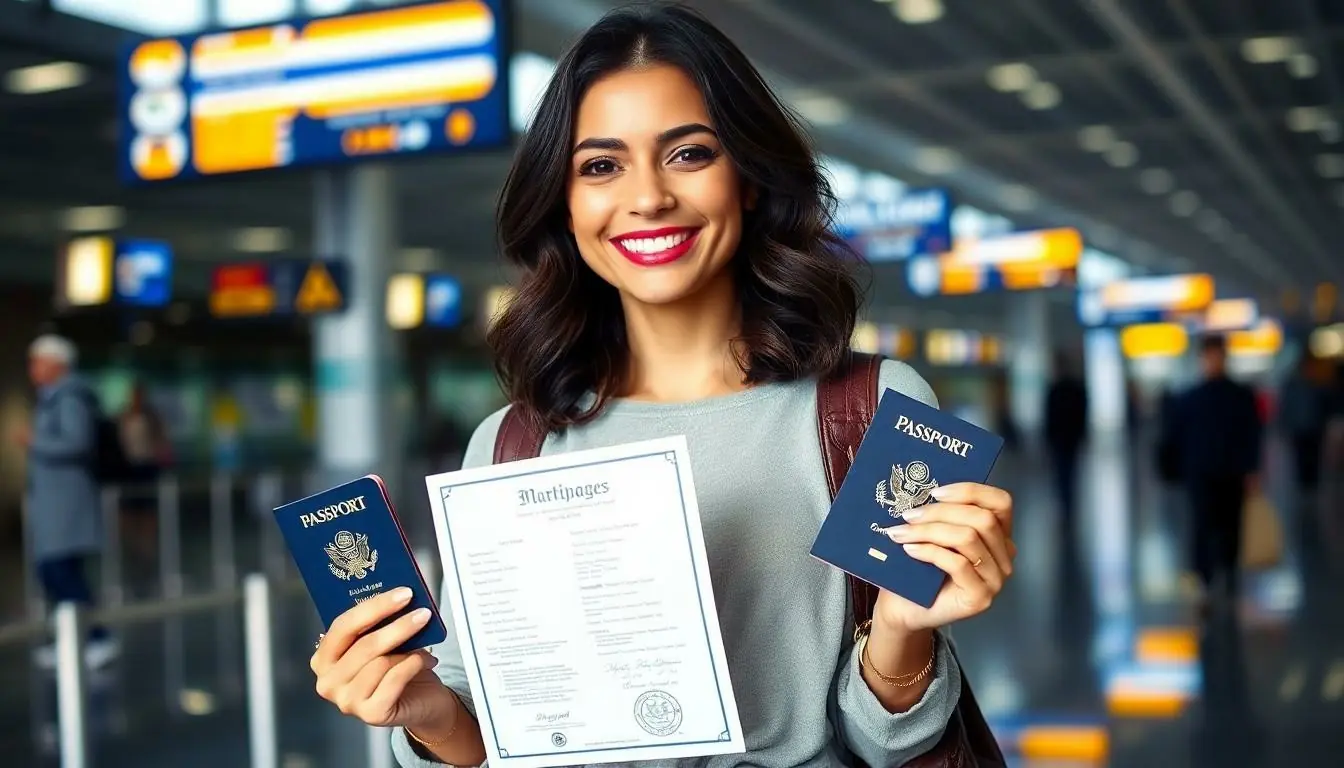Marriage is a beautiful journey, but it often comes with a few bureaucratic bumps along the way. One of the biggest questions newlyweds face is whether they need to change their name on their passport after tying the knot. After all, who wants to be that person at the airport, waving a passport that doesn’t match their new last name while trying to board a flight to paradise?
While some might think a name change is just a formality, it can actually save a lot of hassle down the road. Imagine the confusion when your travel plans are interrupted by a mismatched name. So grab a cup of coffee and settle in, because understanding the ins and outs of updating your passport can make your post-wedding adventures a lot smoother.
Table of Contents
ToggleUnderstanding Name Changes After Marriage
Understanding the impact of a name change after marriage is crucial for smooth travel plans. Many individuals choose to adopt a spouse’s last name, but this decision is not mandatory. Those who prefer to keep their current name can travel without complications, provided their passport reflects this name.
Traveling under a name that doesn’t match official identification can lead to issues at security checkpoints. For instance, discrepancies might result in delays or denied boarding. Ensuring that the passport name aligns with the legal name ensures a smoother travel experience.
Updating a passport requires specific documentation. Applicants typically need to submit a marriage certificate, which serves as proof of the name change. Alongside the marriage certificate, they’ll need to fill out a passport application form and provide a recent passport photo.
Timing also plays a significant role in this process. It generally takes four to six weeks to receive a new passport after submitting the application. During peak seasons, this timeframe may extend, so planning ahead is essential.
Many opt to change names on other documents in conjunction with updating their passport, including driver’s licenses and bank accounts. Coordinating these updates helps maintain consistency across all personal identification.
Ultimately, whether changing the name on a passport is necessary depends on personal preference and travel plans. Understanding the implications of name changes helps couples make informed choices about their identity post-marriage.
Legal Requirements for Name Changes

Updating a passport after marriage involves understanding legal requirements for name changes. Different regulations exist, so awareness is crucial for compliance.
Passport Regulations in the US
Passport regulations in the U.S. require a name change to be documented with specific forms. A passport applicant needs to submit Form DS-82 for a name change for renewals. An applicant must provide their marriage certificate as proof of the name change. A recent passport photo also needs inclusion for correct identification. Review times typically last four to six weeks, making prompt applications necessary, especially during peak travel seasons. Non-compliance with passport name regulations can delay travel, so addressing these changes promptly ensures hassle-free plans.
State-Specific Name Change Laws
State-specific name change laws vary significantly across the U.S. Some states allow name changes through marriage without additional documentation. Others require filing a petition or attending a court hearing. Researching local laws is essential as requirements differ widely. Many states offer a streamlined process for updating various identification documents alongside passport changes. The implications of not updating identification can lead to complications, so understanding state-specific laws proves beneficial. For a smooth transition post-marriage, couples should familiarize themselves with these regulations.
Considerations for Changing Your Name
Changing a name after marriage involves various factors. Understanding these factors helps make informed decisions about the name on a passport.
Personal Preferences
Personal preferences play a significant role in the name change decision. Individuals may choose to adopt a spouse’s last name, hyphenate, or keep their original name. Some prioritize tradition when selecting a name, while others favor individuality. Couples might discuss their options and reach a consensus that suits both partners. It’s essential to consider how each choice affects personal identity and social interactions. Preferences can also influence the timing of the name change as individuals may want to align their passport name with other official documents.
Professional Implications
Professional implications arise when considering a name change после marriage. Careers often involve established reputations linked to names, so professionals need to weigh the impact of a name change. Some fields, such as academia or government, may require updates to credentials and publications, which can be a lengthy process. Job titles and professional affiliations might also follow the name used on the passport. For those in the public eye, such as influencers or entertainers, brand identity linked to a name presents unique challenges. Evaluating the consequences in a professional setting can help individuals make critical decisions about changing their names.
Steps to Change Your Name on Your Passport
Changing your name on a passport involves several necessary steps. Following the right process ensures compliance with regulations.
Required Documents
Essential documents for a name change include a marriage certificate, a completed passport application form, and a recent passport photo. The marriage certificate serves as proof of the name change. Applicants must choose between using Form DS-82 for renewals or Form DS-11 for first-time applicants. Each form has specific submission methods; therefore, knowing which one to use is essential. A photo that meets official requirements is also critical, as it should be taken within the last six months and reflect the applicant’s current appearance. Gathering these documents beforehand helps prevent delays.
Application Process
Starting the application process requires filling out the appropriate form based on the type of passport held. Those changing names should submit their application by mail if renewing. It’s important to send all required documents together, including the marriage certificate and passport photo. Tracking the application is advisable, as processing times generally range from four to six weeks. Factors such as peak travel seasons can extend wait times, so planning accordingly is beneficial. Understanding this process streamlines the name change, making future travel hassle-free.
Potential Issues and Solutions
Confusion often arises when a passport name doesn’t match the new last name after marriage. Delays at airport security and potential denial of boarding frequently occur due to discrepancies between identification documents. To mitigate these challenges, changing the name on the passport promptly becomes crucial.
Documentation requirements for name changes can vary by state, adding to the complexity. Some states may require additional paperwork, while others allow a straightforward process. Understanding local regulations plays an essential role in ensuring compliance without unnecessary hurdles.
Application processing times also pose an issue. Typically, it takes four to six weeks to receive a new passport. During peak seasons, these times may increase, leading to potential travel disruptions. To alleviate this stress, applying for a name change well before planned travel is advisable.
Moreover, other official documents often require updates concurrently to maintain consistency. A driver’s license and bank account name change typically follows the passport update. Handling these changes at the same time simplifies identity verification across various platforms.
Communication with partners regarding name preferences presents another consideration. Discussions about choosing to adopt a spouse’s name or retaining the original name can influence future identification. Engaging in this dialogue ensures both parties are on the same page.
Professional implications frequently arise, especially for those with established reputations linked to their names. Individuals in fields requiring credentials or publications may struggle with name changes. Addressing these changes promptly can prevent disruption to their professional lives.
By considering these potential issues and implementing solutions, navigating the name change process becomes more manageable.
Changing a name on a passport after marriage is more than just a formality. It plays a crucial role in ensuring smooth travel and avoiding potential complications. Discrepancies between identification documents can lead to delays or even denied boarding, making it essential to address this change promptly.
By understanding the necessary steps and gathering required documentation, individuals can navigate the process with ease. It’s also wise to consider updating other official documents simultaneously to maintain consistency. Ultimately, making informed decisions about a name change can significantly enhance travel experiences and personal identity post-marriage.








